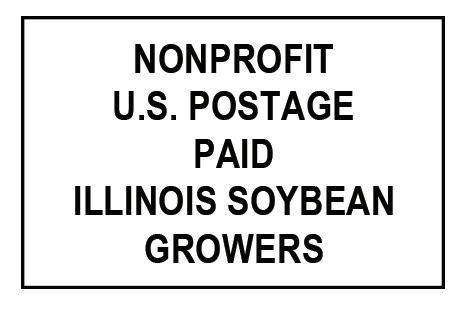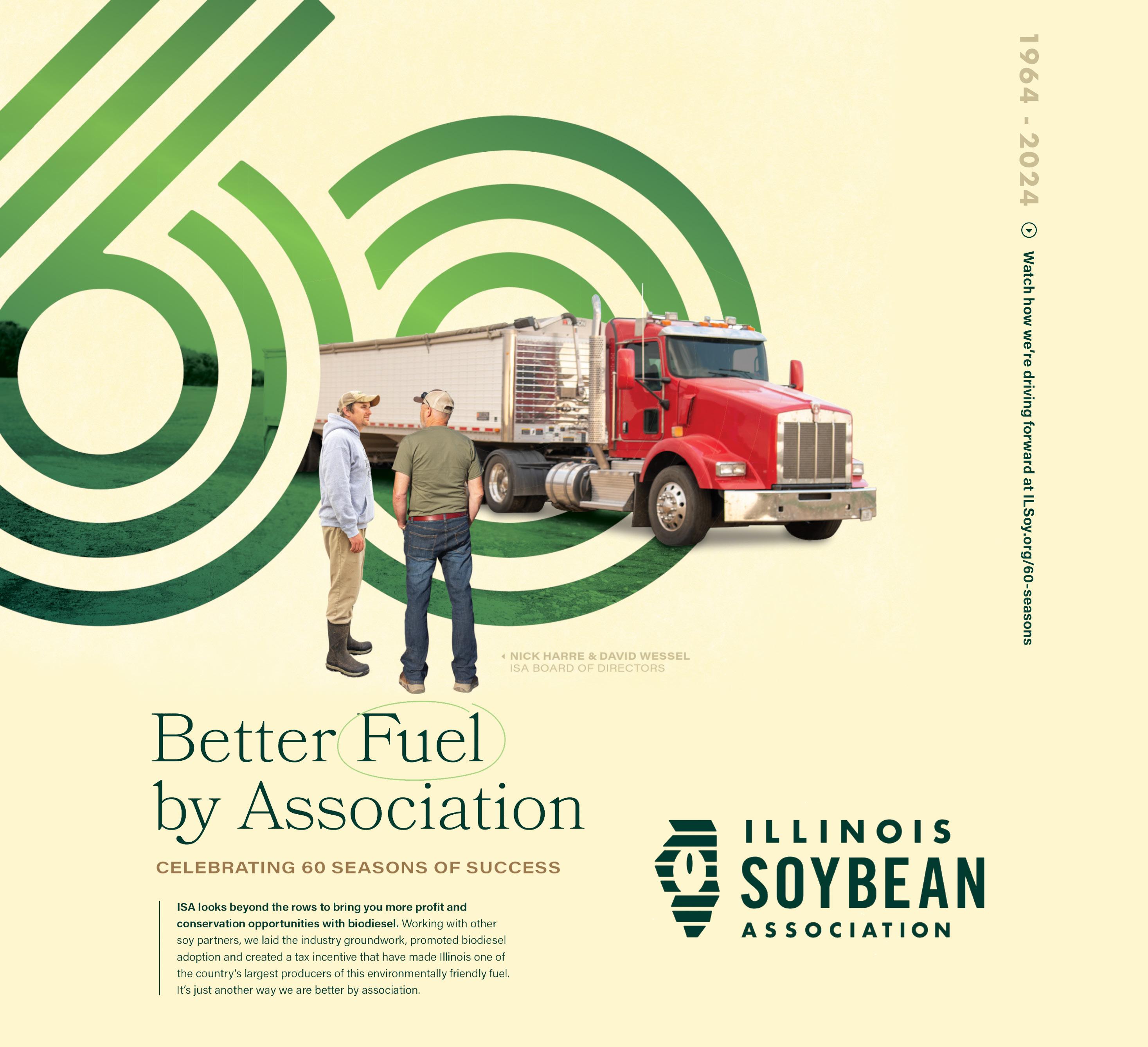








4
How ISA’s new On-Farm Trial Network will redefine the future of soybean production.
ISA Research Data Scientist Stacy Zuber explores the biology and behavior of Illinois soil and the processes that affect it.
Learn more about ISA's “It’s Sustainably Soy” certification program, which recognizes companies and organizations that incorporate soy-based inputs into their products and projects.
ISA and IFCA partner to present an upcoming agronomic event for Illinois growers.
More investment is needed to stabilize funding for soil and water conservation districts that empower Illinois farmers' conservation use, writes ISA Environmental Policy Manager Corey Lacey in this editorial.
Once the stuff of movies and fan fiction, robots show incredible potential for practical work and impact on Illinois soybean farms.
A recent University of Illinois study aims to make it easier for Illinois soybean growers to determine a 2024 cover crop strategy and help slip them into your existing rotation.

COVER: Good for the environment? Check. Good for the local economy? Check. Good for Illinois soybean farmers? Check. This issue of Field & Bean takes a deep dive into sustainable agriculture which conserves natural resources, biodiversity and labor, increases available soil water, reduces heat and drought stress, and builds up soil health in the longer term. The big-picture payoff of conservation farming is that helps farmers to maintain and boost yields and increase profits, while reversing land degradation and protecting the environment.
CHAIRMAN
Ron Kindred, Atlanta District 9
VICE CHAIRMAN
Brad Daugherty, West Union District 14
SECRETARY
Tim Scates, Carmi At-Large
TREASURER
Bryan Severs, Potomac District 7
ASSISTANT SECRETARY-TREASURER
Dwayne Anderson, Lynn Center District 3
GOVERNMENT RELATIONS COMMITTEE
CHAIR
Steve Pitstick, Maple Park District 2
MARKET DEVELOPMENT COMMITTEE
CHAIR
Brian Atteberry, Carmi District 16
SOYBEAN PRODUCTION COMMITTEE
CHAIR
Brady Holst, Plymouth At-Large
DIRECTORS
Ryan Frieders, Waterman | District 1
Buck Hill, Grand Ridge | District 4
Mark Read, Putnam | District 5 Jim Martin, Pontiac | District 6
STAFF CREDITS
Publisher | Michael Whitmer
Managing Editor | Betsy Osman
Assistant Editor | Olivia Key
Staff Contributor | Brynna Sentel
OTHER ISA STAFF
Chief Executive Officer | John Lumpe
Director of Operations | Dustin Scott
Director of Market Development | Todd Main
Director of Finance | Kati Owen
David Niekamp, Coatsburg | District 8
Elliott Uphoff, Shelbyville | District 10
Matt Murray, Paxton | District 11
Brock Willard, Pittsfield | District 12
Heath Houck, Nokomis | District 13
Jeff Parker, Belleville | District 15
Nick Harre, Nashville | District 17
Rick Rubenacker, McLeansboro | District 18
AT-LARGE DIRECTORS
Betsey Emerick, Vandalia Jeff O'Connor, Kankakee David Wessel, Chandlerville
UNITED SOYBEAN BOARD (USB)
Dwayne Anderson, Lynn Center
Gary Berg, St. Elmo
Lynn Rohrscheib, Fairmount David Wessel, Chandlerville
AMERICAN SOYBEAN ASSOCIATION (ASA)
Stan Born, Mahomet
Daryl Cates, Columbia Jered Hooker, Clinton
Jim Martin, Pontiac
Bill Raben, Ridgway
Rob Shaffer, El Paso
Roberta Simpson-Dolbeare, Nebo
Bill Wykes, Yorkville
Director of Government Relations & Strategy | Andrew Larson
Director of Agronomy | Abigail Peterson
Illinois Soybean Growers (ISG) is owner of Illinois Field & Bean, a publication for Illinois soybean farmers, designed and written to provide timely and useful industry information. Illinois Field & Bean is published by the Illinois Soybean Association, 1108 Trinity Lane, Bloomington, IL, 61704. For address corrections, contact Illinois Field & Bean at 1108 Trinity Lane, Bloomington, IL, 61704. Phone 309-663-7692. Web address: www.ilsoy.org. Email: ilsoy@ilsoy.org.
Comments and statewide news articles should be sent to the above address. Advertising space reservations must be made by the first of the month preceding publication. In consideration of the acceptance of advertisement, the agency and the advertiser must, in respect of the contents of the advertisement, indemnify and save the publisher harmless against any expense arising from claims or actions against the publisher because of the publication of the content of the advertisement.
FOR ADVERTISING INFORMATION
Michael Whitmer
Publisher
Email: michael.whitmer@ilsoy.org

As we enter the fields to plant each year, the Illinois General Assembly wraps up its legislative session in Springfield. It’s important that we reflect on the significant strides we have made in shaping policy that affects our livelihoods and our industry. We should also acknowledge the challenges that lie ahead. As farmers who are engaged with the professional team at Illinois Soybean Growers (ISG), we have made certain that our collective message is heard and echoed throughout the Capitol.
Our opinions matter. Our farming legacies are directly impacted by a variety of policies. This includes environmental legislation such as pesticide regulations and wetland protection regulations. It extends to the estate tax and rules on carbon sequestration.
In the most recent session, ISG advocated for increasing funding for the Illinois Department of Agriculture’s (IDOA's) Fall Cover for Spring Savings program. Historically, this program has been oversubscribed and underfunded despite the overwhelming number of farmers who apply each year. This year, ISG pushed for an increase from $660,000 (covering 100,000 acres) to $3.1 million (covering 5000,000 acres). Unfortunately, we encountered opposition because of concerns about expanding the program too aggressively. Despite the opposition, legislators secured a 50 percent funding increase for Illinois farmers. ISG remains committed to making agriculture, and support for adoption of voluntary conservation practices, a priority in Springfield.
One of the top priorities for agriculture this legislative session: estate tax reform. Currently, the Illinois Estate Tax threshold is $4 million. With the cost of farmland dramatically increasing, farmers are having to sell off portions of their land as the farm transitions to the next generation. This enables them to pay the resulting estate tax. Although the state's $53.1 billion budget did not include reform of the estate tax, our efforts were not in vain. Throughout the fight, ISG collaborated with key entities such as the Commission on Government Forecasting and Accountability, the Attorney General's Office, the Treasurer's Office, and the House Revenue Chair's Office. As of this writing, the Attorney General's Office is preparing to release detailed data on annual estate characterictics. This strategic move sets the stage for a more informed, robust estate tax plan in the coming years. It will allow ISG to continue this work to ease the burden on growers.
None of these proposed changes became law, but they are sure to reappear in the future. Whether it was on the wetland legislation, the lack of conservation support, the proposed Clean Fuel Standard, or the carbon capture bill, many of the proposed benefits would ultimately harm many Illinois farmers. ISG remains committed to representing all of Illinois. It will push for outcomes that work for Illinois farmers, not just one market or commodity over another.
Farmer to farmer, we stood together this legislative season and made our voices heard. Our unity and determination have proved that when we come together, we can influence genuine change. We must continue to build on the momentum we have generated. Not only do we need to stay at the forefront of current challenges, we must also be proactive to anticipate future obstacles. This involves continued engagement with policymakers, research to advocate for better policies, strengthened alliances with other agricultural organizations, and ongoing collaboration with ISG – the largest farm organization in Illinois representing soybean farmers.
As we move forward, let’s remain committed to our cause and to one another. Our work together is far from over, but with each year, we grow stronger and more influential, a powerful force in shaping farm policy. During these days of division and political unrest, perhaps agriculture’s greatest opportunity lies in our ability to educate and advocate for the freedom to farm and feed the world.
For the past four years, it has been my honor and privilege to serve as the Chief Executive Officer of the Illinois Soybean Association (ISA). When the Board of Directors selected me for this role, one of the things we committed to do together was to make a difference for farmers across the state of Illinois. One of the many things I find rewarding is seeing the team grow across the organization. We've worked to build a strong bench of industry experts and passionate advocates for agriculture who stand at the ready to collaborate with other interested groups.
In our Market Development team, we are focused on supporting farmers both domestically and abroad. Since I began at ISA, we’ve also developed an internal Agronomy team that is working with many instate researchers and on-farm trial networks to ensure Illinois soybean farmers continue to have access to cutting edge and relevant information to support their farms.
Over the past four years, we've had the opportunity to develop a new strategic plan under the leadership and direction of our volunteer Board of Directors. This process began at the height of the COVID pandemic. It took the vision of our Board and the commitment of our staff to realign our organization to meet new priorities of the organization. One of those priorities was the creation of a Government Relations committee on our Board of Directors. Like many other Illinois commodity groups, policy and legislative engagement has always been an element of ISA's work. Yet the creation of this dedicated committee of farmer leaders working hand in hand with our staff has delivered deeper value to the work we're doing on behalf of Illinois farmers.
In this state, we have a major challenge. The geography of our state alone means that the majority of legislators in our state's General Assembly and congressional delegation are from districts that include less and less of rural Illinois and productive farmland. This is a trend that is happening nationally, but in Illinois, we are experiencing it at an increasingly rapid pace. As part of our strategic plan, ISA has committed to telling Illinois farmers' stories and communicating their needs to lawmakers to ensure they can continue their farming operations. This educational effort is a monumental undertaking. Oftentimes, legislators have some familiarity with parts of agriculture. But when they see the whole landscape, they’re often impressed by the breadth of impact that we have on our state and the world.
Another key part of our strategy is to develop policy expertise that specifically focuses on issues that impact Illinois farmers. These impacts are seen in markets, regulation of production practices, access to farm programs, conservation support, reliable transportation networks, and other key areas. To support these, we have recently expanded

JOHN LUMPE | CEO | ILLINOIS SOYBEAN ASSOCIATION
our Government Relations team to include nine staff members. They work directly on achieving better legislative and regulatory outcomes for Illinois farmers. The team is based partly in our Bloomington office but also has members based in our suburban Lombard office, allowing more direct access to legislators in that region. This year, Illinois Soybean Growers (ISG) also opened a legislative office just across the street from the State Capitol in Springfield to serve as a base of operations to engage during legislative session.
As you will read throughout this magazine issue and into the future, we will continue to bring you updates and information about key issues affecting Illinois soybean farmers. The work we are doing together is resulting in high-value, high-impact benefits for Illinois farmers. As CEO of your Illinois Soybean Association – the state’s largest soybean-focused farm organization - I'm proud of the work our team is doing. I'm honored to have the support of our Board of Directors as we work together to better serve every farmer across Illinois.


By Nate Birt
After graduating college, Abigail Peterson didn’t return home to the farm. Her father and uncle didn’t have room in the operation for another team member.
So Peterson, now the Director of Agronomy at Illinois Soybean Association (ISA), spent time serving other farmers as an agronomist. Along the way, she learned from their conservation wins and mistakes. And she picked up lessons about cover crops and other stewardship practices she could take back to her family’s farm.
“I always looked at systems out in the fields [and asked], ‘Would this be something I would want to talk to my dad and uncle about’?” Peterson shared during a presentation at the 2024 Better Bean Summit. “Because if I came to them to the table and said, ‘Hey, you should try cover crops,’ I’d better have a good first season.”
That same determination to speed up the rate of success with conservation practices across Illinois soybean farms informs the new On-Farm Trial Network. Organized by ISA, the effort will span three types of on-farm research studies designed to minimize risk, maximize resilience and optimize profit with conservation and other agronomic practices.
“We are the number one soybean-producing state in the U.S., so shouldn't we be a leader in the research that we're doing in the Midwest and even in the world?” noted Stacy Zuber, ISA Research Data Scientist, during the Better Bean Summit presentation. “That's our goal.”
Research is nothing new to Illinois farmers and ISA, which has 16 research studies underway as of this writing. What’s novel about the On-Farm Trial Network launching this fall is the opportunity to address a series of unprecedented marketplace demands while making conservation more accessible faster.
For example, the Illinois Nutrient Loss Reduction Strategy calls for farmers to reduce total nitrogen and phosphorus loss by 45 percent of the total nitrogen and phosphorus leaving the state and entering waterways. What’s more, in 2017 alone, 101.5 million tons of soil left Illinois fields, meaning there’s plenty of room for improved soil retention and water-holding capacity, among other conservation benefits.
“There's a pressure for you to
adopt practices that reduce losses using no-till, using reduced tillage, using cover crops. As a soil health person, I would love to say every single one of you should put that in your fields right now,” Zuber says. “But realistically, that's not going to happen. If we can find the answers to the questions of, ‘How can we make this work better for you? How can we minimize those risks? How can we make sure that this works? How can we speed up? How quickly does it work?’ Those are some of the things we want to address.”
You can think of the On-Farm Trial Network like a bridge that fills the gap between traditional university-based research and industry research.
University research remains essential for farmers, yet it often
takes substantial time and requires significant statistical analysis, Zuber says. ISA’s network of agronomists can help farmers more quickly access quality, scientifically valid insights.
Additionally, ISA will provide an important layer of practical, realistic and independently verified information compared to industry research, which Zuber says remains vital yet can suffer from bias.
Three types of on-farm trials will provide the state’s soybean producers with more learning opportunities focused on conservation and other agronomic practices:
• Demonstration Trials: These low-intensity trials will focus on gleaning observational details about how a conservation
(See Conservation’s Next Chapter, page 8)
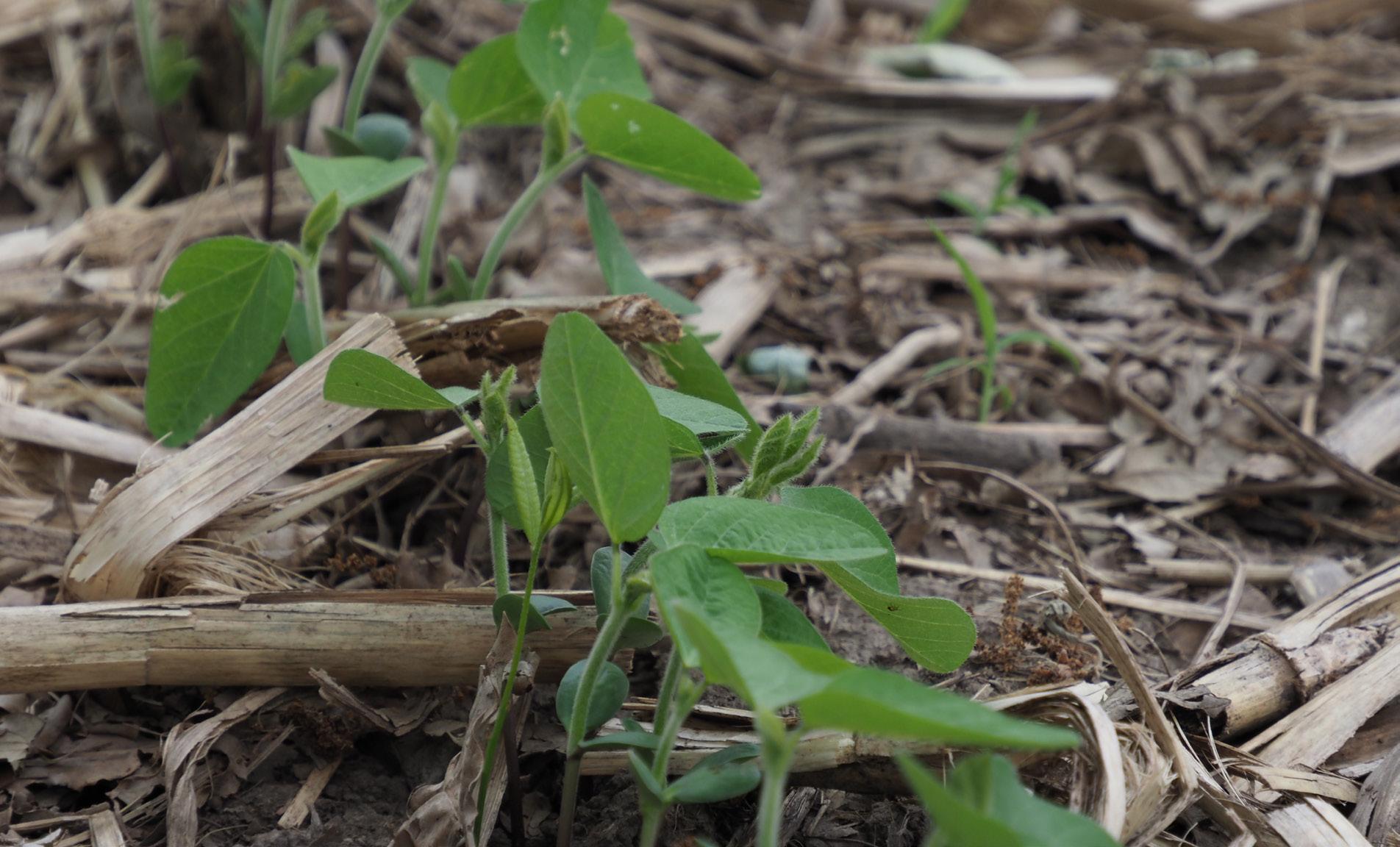
(continued from page 7)
practice is working. Agronomists might take tissue tests and soil samples to collect limited data points. But there will not be statistical analysis. “The goal of this is to be able to test things out and see if it’s worth doing more work into. Or maybe it’s just to show farmers at field days, ‘This is how it worked for me, this is how it worked on these soils,’” Zuber explains. A combination of split fields or even check strips are anticipated. These trials can be conducted on small acreage or an entire field, depending on farmer interest and research questions under investigation.
• Action Trials: These shortterm trials will likely run just a few years and can be used to respond to emerging Illinois farmer needs. For example, controls and treatments could be run to understand key challenges or opportunities facing farmers in southern Illinois, northwest Illinois or beyond. “The goal with these is to be able to get actionable guidance and recommendations to you to fit your operational needs,” she says.
• Legacy Trials: Several farms already have trials underway, and these will be included in the network. These long-term replicated strip trials will examine the effect of conservation practices such as cover crops, no-till and strip till on soil health, among other issues. “It takes a long
time to see those changes in the soil, so we need to make sure that we are having trials that are set up and in place long enough to see those differences,” Zuber says.
Conservation practices studied in both Action Trials and Legacy Trials will be subjected to statistical analysis to examine variation among fields and other factors. This will help researchers determine whether the practice itself is contributing to a beneficial outcome—or if the outcome is likely a product of differences in fields and soil types.
Learnings from the On-Farm Trial Network won’t just benefit farmers. They can also strengthen ties between ISA and the U.S. Department of Agriculture’s Natural Resources Conservation Service (NRCS). Statistical analyses and
other data could help NRCS adjust conservation practice standards in a way that’s a better fit for Illinois farmers, Zuber says.
If you are interested in participating in the On-Farm Trial Network, you can contact ISA to learn more. ISA seeks to enroll farmers from across the state.
Over summer 2024, ISA will compile this information and organize the network.
“We are planning to ramp this up throughout this year, hopefully to start putting more of these in place this fall,” Zuber says.
For the latest Illinois conservation agriculture blog posts and more information about the On-Farm Trial Network, visit ILSoyAdvisor.com.






By Stacy Zuber, Ph.D., Research Data Scientist, Illinois Soybean Association
One of the most overlooked characteristics of soil is actually the easiest part of the soil for you to see. In fact, every time you walk out into a field, you have direct contact with it—it’s the soil surface. And, while most farmers are happy to dig into it to check their furrow closure and keep an eye out for standing water, not too many know just what processes affect how that soil surface behaves. For example, what happens when it rains or dries or has the weight of equipment driven over top of it?
Soil is made up of mineral particles of different sizes—clay is the smallest, followed by silt. Both are too small to see an individual particle with the naked eye. Sand is the largest mineral particle, up to 2 mm in diameter. Each soil has a different ratio of those three particles, giving it a particular soil texture. Most soils in Illinois are somewhat close to silt loam or silty clay loam, though areas near rivers have much higher sand content. All of that might be just a refresher on things you already knew. But what many farmers might not realize is that for the soil surface, an even more important aspect is how those different mineral particles are linked to each other. Do they
lightly connect but break apart with the slightest wind or water forces? Or better yet, are those particles tightly glued together into large structures, which we call aggregates?
It might seem a little counterintuitive to want soil particles that stick together. After all, we generally talk about wanting good soil tilth, which is the physical condition of the soil and how suitable soil is for planting and growing crops. Often, discussion of soil tilth is connected with good seedsoil contact and sometimes considered in relationship to soil tillage. So wouldn’t it make sense that we want soils to break apart so the particles can get better contact with the seed in the furrow? Yes, that’s definitely true for soil clods that form after soils are tilled or disturbed. We want those soils to crumble. But the goal is for those soils to crumble into the soil aggregates and not into the individual soil particles. In fact, this might be one of the biggest issues a farmer can face with soil structure. That's because if those individual soil particles break apart, they can cause all sorts of issues compared to soils that have particles that stay glued in larger soil aggregates.
Mother Nature always causes issues, but they seem to be showing up at higher rates in recent years. Farmers face more frequent heavy rainfall events that interfere with planting and other
field operations. Heavy rainfalls of 2 inches in a single day or even in a few hours can dump over 54,000 gallons of water per acre. The aggregation of soils plays the biggest role in what happens to that water when it hits the soil surface.
When soil particles are glued together into strong and stable soil aggregates, it creates more open pore space within the soil. That open pore space is vital for water to be able to infiltrate and be absorbed into the soil. When soils have few glues or the glues are weak, soil aggregates might barely exist and break apart easily. This can happen just from the force of a raindrop falling and hitting bare soil. When those particles break loose, they are now free to move in the water. They may leave in runoff, carrying phosphorus and organic matter alongside those soil particles. In the best case scenario, they stay in the field. But this can exacerbate the existing problem. Those loose soil particles still need to go somewhere, and they settle out on the soil surface or maybe move down into the few open pore spaces available to them. This can plug the few existing open pore spaces at the soil surface. It can also lead to problems with soil crusting. Depending on the time of year, it can cause emergence issues in the spring if the crusting is bad enough.
Not only does soil aggregation benefit water infiltration and
reduce erosion, but it can have potential influences on crop yields, particularly in years with extreme weather patterns. We’ve already mentioned the heavy rainfall events that seem to be more and more common. Yet most farmers would love to have a workaround so they can get out and plant quickly after a rain event without risking compaction. We saw that this spring. Rains kept planters out of the field much later than what is comfortable for most. The key to preventing compaction is to always avoid driving on wet soils. In well-aggregated soils, while compaction can still be an issue, the risky timeframe is narrowed. This is because well-aggregated soil allows water to move deeper into the soil profile rather than remaining on the soil surface. Soils with poor aggregation, loose soil particles or plugged particles or pore spaces tend to suffer from trapped water. This creates the worst compaction conditions when heavy equipment is driven over those wet soils. Even in drought conditions such as those farmers faced in 2023 and, to a greater extent, in 2012, good soil aggregation might help reduce yield losses. The open pores and increased water infiltration (when it does rain) help to increase water storage and availability. That means crops grown in those soils might be able to hold off against drought stress for an extended period of time.
(Making Sense of Soil Aggregate Stability, page 22)

(continued from page 11)
So where do those glues that hold soil aggregates together come from? They come from plant roots and soil microbes—bacteria produce polysaccharides and fungal hyphae that help to enmesh soil particles together. It’s the living organisms within the soil that help provide the cement to assist in building the soil structure.
Those glues are also primarily composed of soil organic matter, so building soil aggregates not only creates more carbon storage within the soil but also physically protects carbon within the aggregates from degradation or further decomposition.
The keys to building soil aggregates are to feed the soil biology and protect the aggregates so they remain intact.
Minimizing soil disturbance is key, as tillage not only destroys existing soil aggregates but also reduces fungal populations that are key contributors to building soil aggregates in the first place. Soils that are frequently tilled typically have very poor
aggregation. This leads to issues with poor water infiltration, runoff and erosion. It also makes soil more susceptible to compaction when the weather doesn’t cooperate. Reduced tillage or strip till can still allow for good aggregate so long as they are paired with other practices that feed the soil biology. It’s important to give soil microbes as diverse a diet as possible, whether through diverse crop rotations (even if simply adding wheat to a corn-soy rotation) or branching into cover crops. Advanced methods could include grazing cover crops and integrating livestock or just using a multi-species cover crop mix.
Building soil aggregates takes time, but even just a few years of reducing tillage and adopting cover crops can improve water infiltration and reduce other issues resulting from poor soil aggregation.
To learn more about strategies for improving soil aggregate stability, you can download a PDF copy of "Building Soils For Better Crops Fourth Edition" by Fred Magdoff and Harold Van Es, published by USDA's Sustainable Agriculture Research and Education (SARE). To do so, visit https://www.sare. org/resources/building-soilsfor-better-crops/

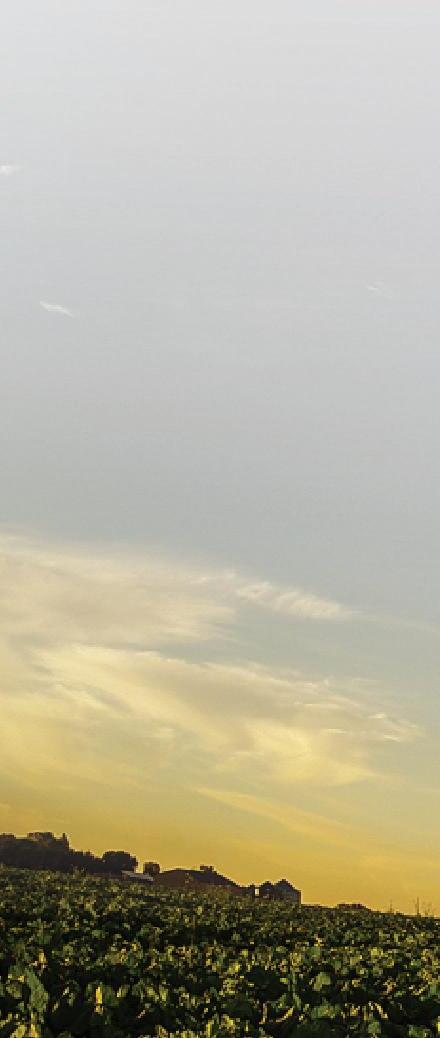




TA Per Acre $
To help cover the start-up costs of cover crops, Farmers for Soil Health o ers financial assistance of up to $50/acre over a three-year period.
Enrollment in Farmers for Soil Health provides access to an exclusive future marketplace connecting farmers to top-tier supply chain partners that are focused on sustainability.
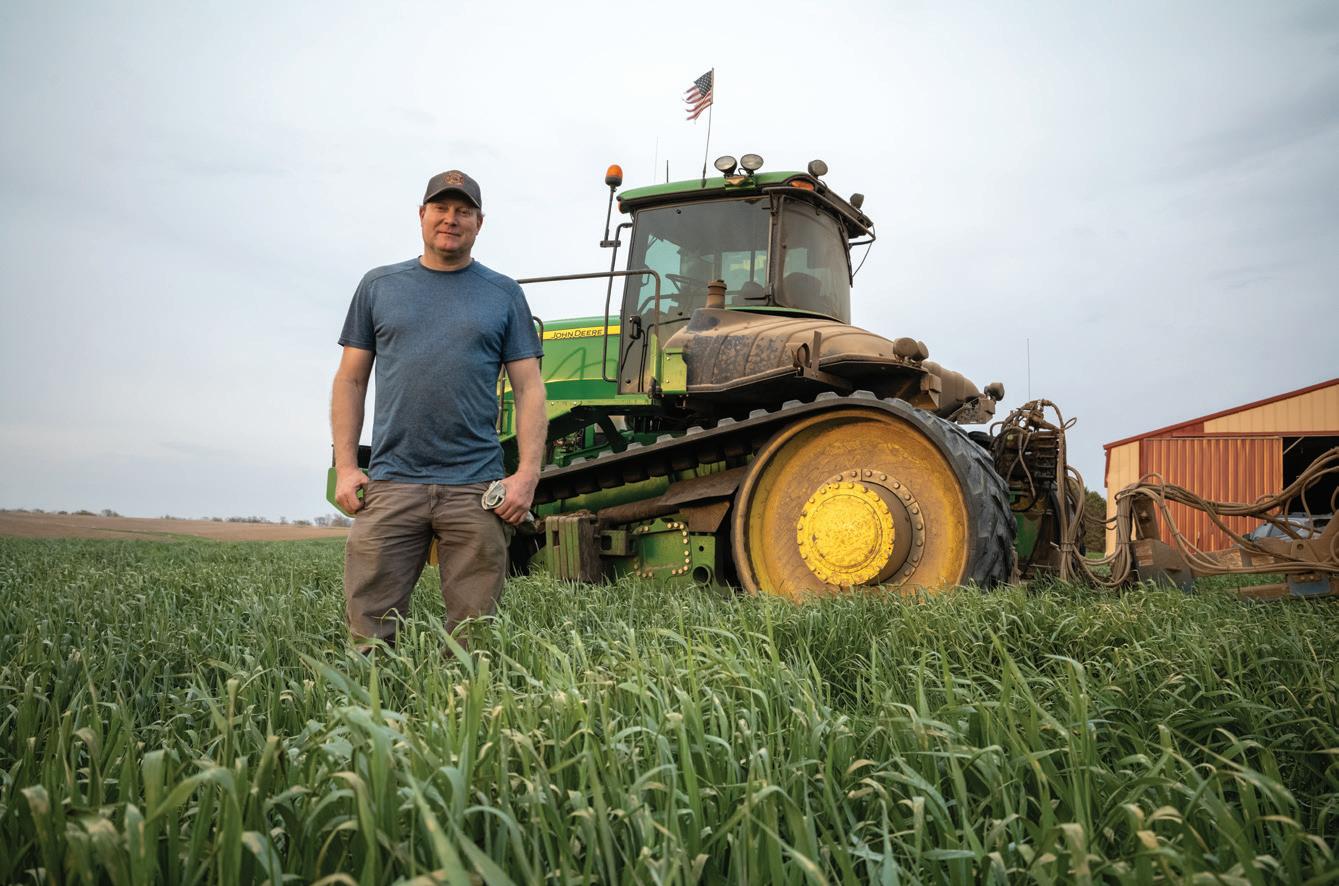
Each state has dedicated on-theground technical advisors to provide research-based information and educational resources to aid in the transition of your field.
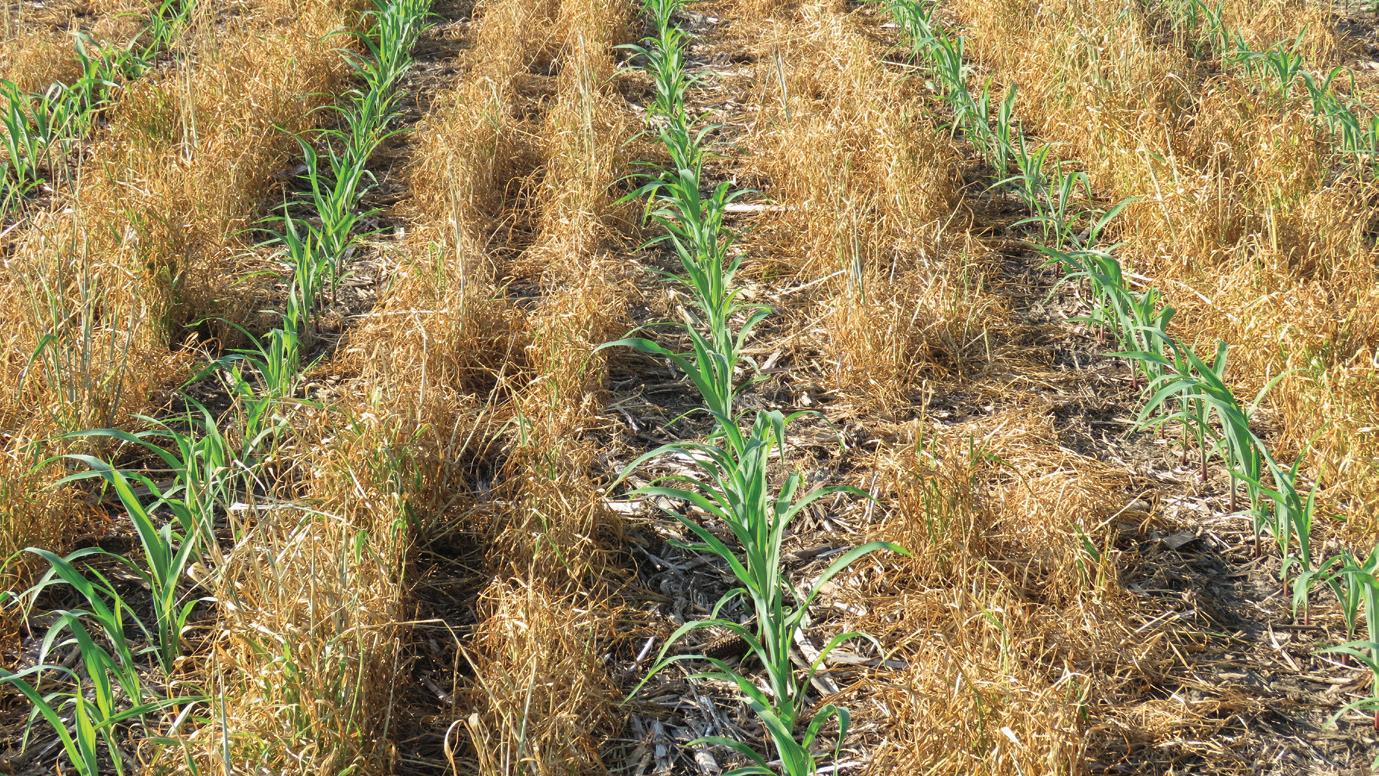


By Olivia Key
The Illinois Soybean Association (ISA) Market Development team is on a mission to increase the use of sustainable, soy-based solutions for the benefit of future generations of farmers and consumers.
Through the “It’s Sustainably Soy” Certification Program, producers and users of soybased products can apply for certification from ISA.
“The program recognizes companies, organizations and executives that incorporate soybased inputs in their products or projects,” said ISA Market Development Coordinator Jaidyn Miller. “As consumers and companies shift away from carbon-intensive chemicals, adopting soy-based inputs promotes environmental sustainability, boosts the economy and supports family farms here in Illinois.”
Miller, who leads the program, is excited about the potential
benefits it will bring to Illinois farmers. “The program will pique consumer interest in companies striving for sustainability and gaining recognition for producing sustainable products. This, in turn, increases demand for soy, which directly benefits our farmers by creating new market opportunities,” she explains.
“Additionally, 'It’s Sustainably Soy’ raises awareness of ISA’s initiatives and Illinois’ position as a leader in the soy-based product industry.”
Earning certification from ISA allows organizations to enhance their sustainability initiatives with a recognized credential.
Once accepted, organizations receive an “It’s Sustainably Soy” Certification Toolkit, which aids in promoting the certification within the organization, in digital markets and across social media channels.
As of May 31, 10 companies and 50 products had earned the “It’s Sustainably Soy” Certification. Keep reading to learn more about each business, their commitment to sustainability, and to explore
their soy-based product offerings.
Clean City Innovations, LLC is an Illinois-based company whose Specialty Product line has allowed facilities to go green while maintaining performance. They sell efficient and sustainable lines of graffiti removers, cleaning products and industrial degreasers.
They have two sustainably certified products:
• Clean City Pro Red Label
Heavy Duty Graffiti Remover
• Clean City Pro Blue Label Gel
Heavy Duty Graffiti Remover
To learn more, visit: www.cleancityinnovations.com.
Cottage Goods is an Oklahoma-based company that began making soy candles in 2000 to reduce the soot and toxins in the founder’s home. To offer their candles at the local farmers market, Cottage Goods
formed the Soy Candle Cottage in 2005.
Further research into soy uses for body products led them to add natural soy lotions and creams, as well as natural Beard Balm and Shaving Soap for men. Cottage Goods has two Sustainably Certified products:
• Hand-poured soy candles and melts (to use in warmers)
• Natural lotions
Visit www.cottagegoods.com to learn more.
EDEN Concept Fill is a California-based company that is on a mission to reinvent comfort by creating biochemically-produced cushioning.
EDEN Concept Fill has one certified product that is a sustainable and scalable alternative for synthetic Polyfoam cushioning. It can be used for sofas, beds, automotive seating, plane seats, insulation, and packaging:
• Cellyfill Visit www.eden-cellyfill.com to learn more.
Franmar is a family-owned manufacturer based in Illinois. For over 35 years, they have developed formulas that harness the power of soybeans rather than relying on acetone, mineral spirits or other oil-based products.
Franmar has 23 sustainably certified products:
• BLUE BEAR Soy Gel
• BLUE BEAR Soy Gel Spray
• BLUE BEAR Soy Gel 600GL
• BLUE BEAR Soy Gel Spray 610GL
• BLUE BEAR Hard Surface Graffiti Remover
• BLUE BEAR Porous Surface Graffiti Remover
• BLUE BEAR Hard Surface Graffiti Remover 680HS
• BLUE BEAR Porous Surface Graffiti Remover 682PS
• BLUE BEAR Bean Mastic Remover
• BLUE BEAR Bean 500MR Mastic Remover
• BLUE BEAR Ickee Stickee Unstuck Adhesive Remover
• BLUE BEAR Ickee Stickee Unstuck 740AD Adhesive Remover
• Franmar Ickee Stickee Unstuck Adhesive Remover
• BLUE BEAR BEAN Asphalt Remover
• BLUE BEAR BEAN 300RE Asphalt Remover
• BLUE BEAR BEAN 360AR Asphalt Release
• BLUE BEAR Concrete Form Release 800GP
• Franmar BEAN Plastisol Ink Remover
• Franmar Greeneway Ink Remover
• Franmar UV Ink Remover
• Franmar Wash Away
Solvent Ink Remover
• Franmar D Haze; Franmar D Haze Gel
• Franmar Haze Remover ES Visit www.franmar.com to learn more.
Low Mu Tech is operated by a group of multi-generational farmers in Iowa who provide innovative solutions for agriculture problems.
They have one sustainably certified product that is a direct replacement to talc and graphite:
• Low Mu Tech DUST Visit www.lowmutech.com to learn more.
Natural Soy is an Iowa-based company that sells renewable, reliable and non-toxic lubricants and cleaners. Their products are proven to be safe for the environment, people, plants and animals that might come into contact with them.
Natural Soy has seven sustainably certified products:
• Graffiti remover/paint stripper – (California DOT Approved Product)
• Gearhead 5th wheel grease pads
• Gearhead penetration lubrication oil
• Asphalt remover
• Adhesive remover
• Concrete form oil
• Railroad rail lubrication stick Visit www.natsoy.com to learn more.
HempWood, a Kentuckybased company, aims to create a brighter future for our planet and boost American manufacturing by introducing sustainable building materials
with a negative carbon footprint.
They have two sustainably certified products that feature soy-based adhesives:
• HempWood Lumber
• HempWood Natural Flooring
Visit www.hempwood.com to learn more.
For over 40 years, Solvent Systems International, based in Illinois, has helped customers clean cleaner, use resources more efficiently and implement the latest innovations in pollution prevention technology. They have eight sustainably certified products:
• Soy methyl ester
• Soy graffiti remover
• Soy Ultrasolve
• Soy crude glycerin
• Soy refined glycerin
• Soy glycerin dust control
• Soy glycerin ice melt
• Soy mastic remover
Visit www.solvent-systems.com to learn more.
Farm to Wick is a womenowned and -operated candle
company located in rural Stanford, Ill. Their candles are made of soy wax produced in the Midwest. The wax is allnatural, burns clean and has a 40- to 60-hour burn time
Farm to Wick has three sustainably certified products:
• Candles
• Wax melts
• Lip balm
Visit www.farmtowick.com to learn more.
Lilaque is a women-owned company based in California that sells the first and only soy-based gel system. Most nail polish ingredients are derived from petrochemicals, so Lilaque created a gel nail polish formulated with ingredients derived from renewable vegetable oils for a low- to noodor experience.
They have one sustainably certified product:
• Gel nail polish
Visit www.lilaquenails.com to learn more.
To learn more about the “It’s Sustainably Soy” Certification Program or to get your product sustainably certified by ISA, visit www.ilsoy.org/ soycertification/


By Carley Roberts
The year 2024 marks the tenth anniversary of the Illinois Fertilizer and Chemical Association (IFCA) implementing the 4R Code of Practice. The 4Rs-right source, right rate, right time and right place-are meant to help Illinois farmers apply nutrients in a way that balances economics and environmental stewardship.
A decade after the introduction of the 4Rs, nutrient management remains a priority for soybean growers across the state.
On Sept. 5, the Illinois Soybean Association (ISA) will jointly host a 4R Field Talk with
IFCA to provide Illinois soybean growers with new tools and insights to expand their environmentally and agronomically sound practices within the 4R Code of Practice.
“We are trying to work with others to produce quality field days rather than a large quantity of them,” said Stephanie Porter, CCA and outreach agronomist at ISA. “We want to make them more meaningful for Illinois growers, which is why we are partnering with organizations like IFCA.”
Dan Schaefer, director of nutrient stewardship at IFCA, will be the main presenter for the 4R Field Talk. Schaefer believes that the collaboration between
ISA and IFCA will contribute to advancing Illinois' nutrient loss-reduction strategy.
“From our perspective as retailers, making the right recommendations to our soybean grower customers — and understanding their concerns about conservation practices like tillage, strip-till and cover crops — are the sorts of things that we need to do together as collective organizations serving Illinois growers,” Schaefer said.
“Partnering with ISA for the 4R Field Talk brings both organizations together so we can help each other to make nutrient loss reduction happen in Illinois,” Schaefer said.
The 4R Field Talk will take place at the Illinois Farm Progress Show site (4275 E Mound Rd, Decatur, IL 62526), at ISA’s cover crop demo plots, which Porter explained are in their second year.
“We didn’t have a demo plot in this location before,” Porter said.
“We appreciate Richland Community College and Farm Progress for their willingness to let us utilize their plot, not only during the Farm Progress Show, but also during alternate years.”
This collaborative event is the fruit of feedback from Illinois soybean growers in years
past. “This is something that our soybean growers have requested. They have asked us in our yearend surveys for more hands-on, demonstration-type field days,” Porter said.
Attendees can look forward to a morning of informative demonstrations and conversation on cover crop management, nutrient placement and various cover crop seeding applications. Lunch will also be included.
“This will be more of a demonstration than a presentation-type event,” Porter said. “I would recommend growers come with questions, as it will be a conversational environment.”
Jim Isermann, an independent ag consultant working with ISA, will kick off the event with a conversation on cover crop management.
“We will be walking through the plots and talking through the different cover crop species options,” Isermann said. “This is an opportunity to see cover crops that we aren’t used to in Illinois.”
“In Illinois, we typically use cereal, wheat, rye and barley,” Isermann said. “We will walk through some not-so-common ones,
including legumes, brassicas and summer annuals. We even have a plot that’s part of a wheat rotation, so we can discuss that, too.”
Although the right tool might not be part of the 4Rs, having a variety of tools in your toolbox can make all the difference as you practice good nutrient stewardship. Some of those tools include equipment, which is ever-evolving to meet the demands of the agriculture industry.
Schaefer will continue the cover crop conversation with a demonstration featuring a crop application using an air seeder and drone.
Regarding the “right place” in the 4Rs, application and soil preservation are key. “It’s important that we keep soil in place when applying nutrients so that we can keep them where we place them on the field,” Schaefer said. This event aligns closely with efforts to protect the Lake Decatur watershed, Schaefer noted. “On the fertilizer side for the Lake Decatur watershed, one of the issues is phosphorus and soil getting into the lake.”
Schaefer stressed that it’s vital to protect this body of water, as it is the primary source of drinking water for the city of Decatur. “We need to protect that water source
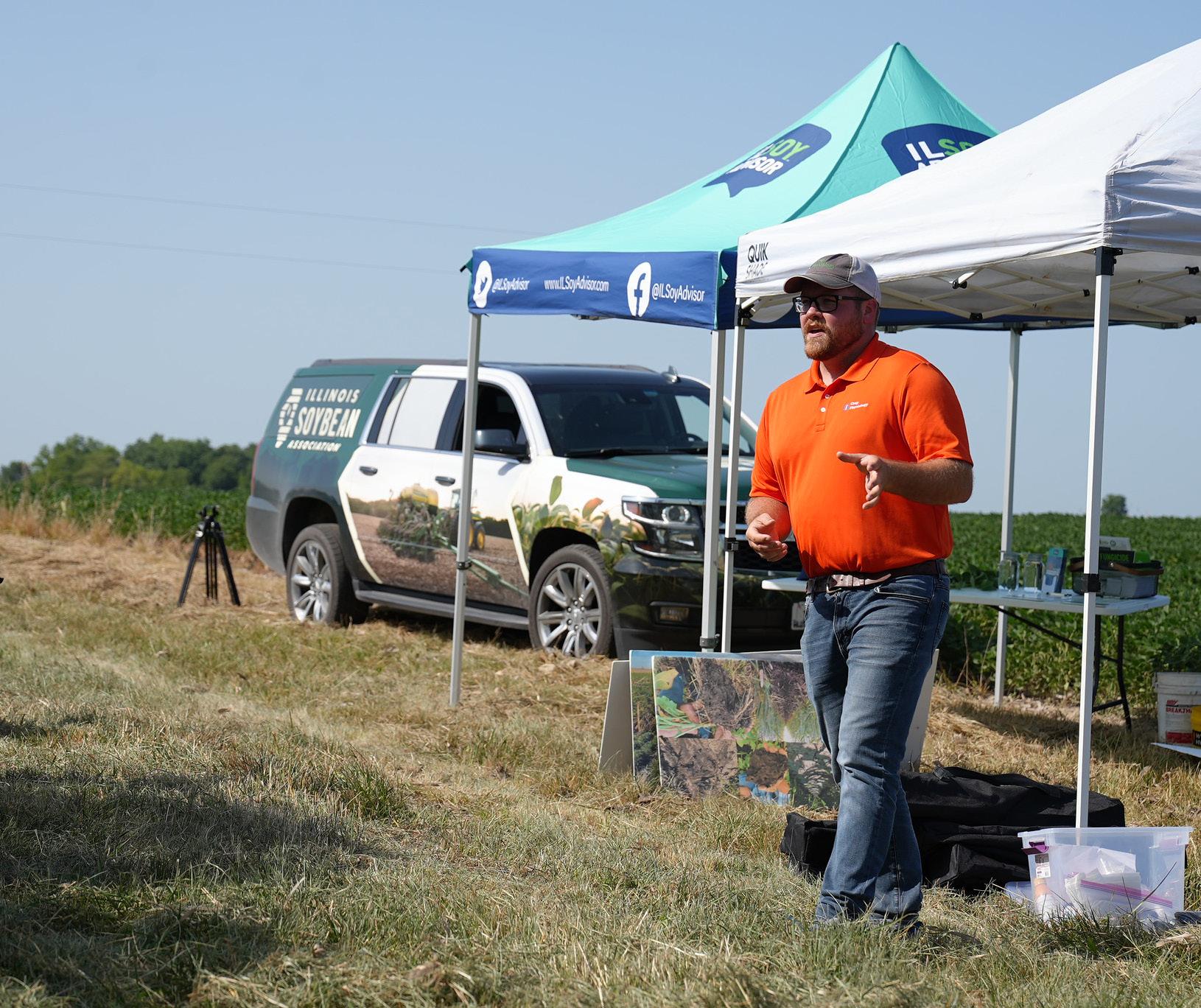
in every way that’s practical.”
“During the field talk, we will demonstrate how to apply dry fertilizer without stripping it, placing it under the soil without disturbing the crop residue,” said Schafer. “It’s important the soil stays covered to prevent the soil from blowing or washing away.”
Schaefer looks forward to putting the Yetter 4000 Nutrient-Pro Coulter to work during the field day. “This tool will inject dry fertilizer under the crop residue and soil surface with minimal disturbance to the soil.”
The 4R Field Talk is an opportunity for Illinois soybean growers to see the equipment in
Date: Thursday, Sept. 5, 2024
Address:
Farm Progress Show Site 4275 E Mound Rd, Decatur, IL 62526
Agenda for the Day:
action and converse with trusted experts who are eager to help growers adopt emerging practices that complement or enhance their existing conservation practices.
Unlike the demonstrations at farm shows that feel years away from adoption, the 4R Field Talk will give Illinois soybean growers a variety of tools they can bring back and implement on their farms in the upcoming crop year.
“We are showing practical solutions to prevent nutrient and soil loss,” Schaefer said.
ISA encourages all Illinois growers to take advantage of this opportunity for hands-on learning.

9:00 a.m. Welcome with Abigail Peterson, ISA
9:15 a.m. Cover Crops with Jim Isermann, Independent Ag Consultant for ISA
10:00 a.m. Break
10:15 a.m. Cover Crop Seeding Applications with Dan Schaefer, IFCA
11:00 a.m. Reducing Tile Nitrate Loss with 4R Management and Cover Crops with Lowell Gentry, University of Illinois
11:30 a.m. Corn Management and Nutrient Placement with Dan Schaefer, IFCA
12:00 p.m. Lunch
12:30 p.m. An IFCA Update with KJ Johnson, IFCA President
To register for this Field Talk, visit https://bit.ly/OFFD_September5th. For more information on all upcoming field days, visit ILSoyAdvisor.com/on-farm-field-days.

through regional summer field events.

By Corey Lacey, Ph.D., ISA Environmental Policy Manager
Illinois farmers are grappling with increasing conservation challenges, including regulatory threats around pesticide and nutrient inputs and market pressures for achieving climate-smart agriculture goals. These challenges necessitate a shift in farm operations, involving the adoption of innovative technologies and best management practices that demand both time and financial investment.
There is a need to support farmers as they adopt conservation. Contrary to popular belief, most of these practices do not yield immediate agronomic benefits. In fact, they introduce new challenges that can impact a farmer’s livelihood. For instance, cover cropping, a well-known conservation practice, can provide agronomic benefits to farmers including increased profitability. Unfortunately, those benefits are often not evident for several years. However, in the short term, cover cropping increases
costs, can reduce yields and may hurt farm profitability. Delayed benefits and increased costs are common hurdles to most conservation measures farmers are encouraged to adopt.
Soil and Water Conservation Districts
These challenges can often be mitigated more quickly with the technical expertise provided by conservation organizations such as Illinois Soil and Water Conservation Districts (SWCDs). SWCDs are a network of 97 county-level
organizations, guided by a volunteer board and in partnership with the U.S. and Illinois agriculture departments, that lead local conservation initiatives. Often located within the local USDA office, the SWCDs play a crucial role in channeling state and federal conservation dollars to help farmers adopt key conservation practices. Meanwhile, their operational funding and staffing are provided by the State of Illinois. Funds provide salaries for dedicated employees who form the “conservation
frontline,” supporting farmer-led conservation efforts.
Unfortunately, SWCDs have been undercut by inconsistent state funding. Over the past 20 years, operational funds provided to SWCDs have averaged $5.5 million annually, or $56,700 thousand per county. During this period, funding has fluctuated dramatically, including a total cut in 2016. Additionally, advocates estimate that attracting and retaining qualified SWCD staff would cost the state closer to $10.5 million annually, suggesting that the districts have never received the state funding needed to accomplish their mission. The history of inconsistent and inadequate state funding hampers individual districts’ ability to retain talented conservationists, who could earn significantly more in the private sector.
In recent years, legislators have made historic investments in SWCDs, with $9 mil -
lion in 2022 and $8.5 million in 2023 and 2024. This gave many the impression that policymakers were beginning to make serious investments in agriculture and conservation. Regrettably, this year saw the General Assembly pass a substantial $4 million cut to the districts, casting a shadow over these positive strides. All the effects of this year’s cuts are not certain. Yet what's clear is it will mean less support for Illinois farmers adopting conservation practices and less actual conservation implemented on the ground.
Conservation funding in Springfield is subject to the whims of politics. Although agriculture has its advocates in the General Assembly, most state legislators represent districts disconnected from agriculture and preoccupied with a multitude of other pressing issues. This is understandable
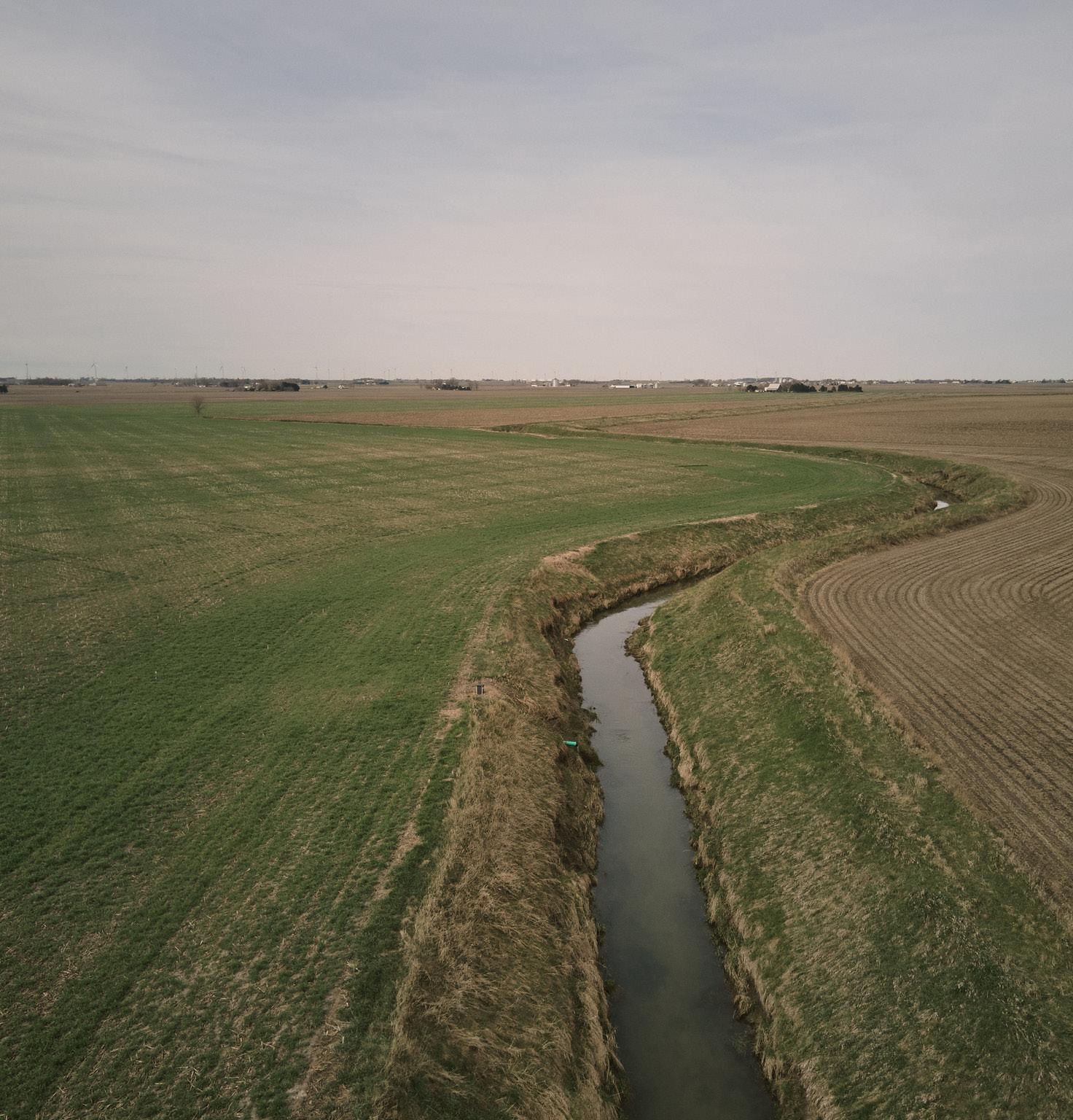
given that running the Illinois state government, the sixth largest U.S. state by GDP, is no small feat. But to ensure adequate funding for the SWCDs and broader Illinois conservation, the General Assembly must act to stabilize funding, insulating it from political discord.
Traditionally, collected state taxes are deposited into the Illinois General Revenue Fund (GRF). Through the budget process, state legislators appropriate conservation funds from the GRF to the Partners for Conservation Fund (PCF). The PCF then allocates these funds for various conservation purposes, including allocating funding for the Illinois Department of Agriculture to support SWCD operations. This process of appropriation and allocation can cause confusion and leaves conservation funding vulnerable to political maneuvering.
This year, at the behest of the Illinois Soybean Growers (ISG), State Representative Ann Williams (D-11) introduced marker
bill HB 5225 to the General Assembly. If passed, a small percentage of state taxes would be directly deposited into the PCF, streamlining the process and bypassing many of the political obstacles that arise during the usual appropriation and allocation process. As a marker bill, HB 5225 was not intended to be enacted this year but rather to highlight the need to stabilize conservation funding.
If Illinois is to address its conservation challenges, support farmers and protect the environment, legislators must consider ways to stabilize conservation funding. This could be achieved by reintroducing and passing HB 5225 in the next session.
You’re invited! Join ISG for our second annual “Pulling for Soy” competition and “EPA Herbicide Strategy Industry Panel” on July 23 in Oakland, Ill. (two events, same day, same place!). Contact Engagement Manager Ashley Barry at ashley.barry@ilsoy.org if you’re interested in attending.
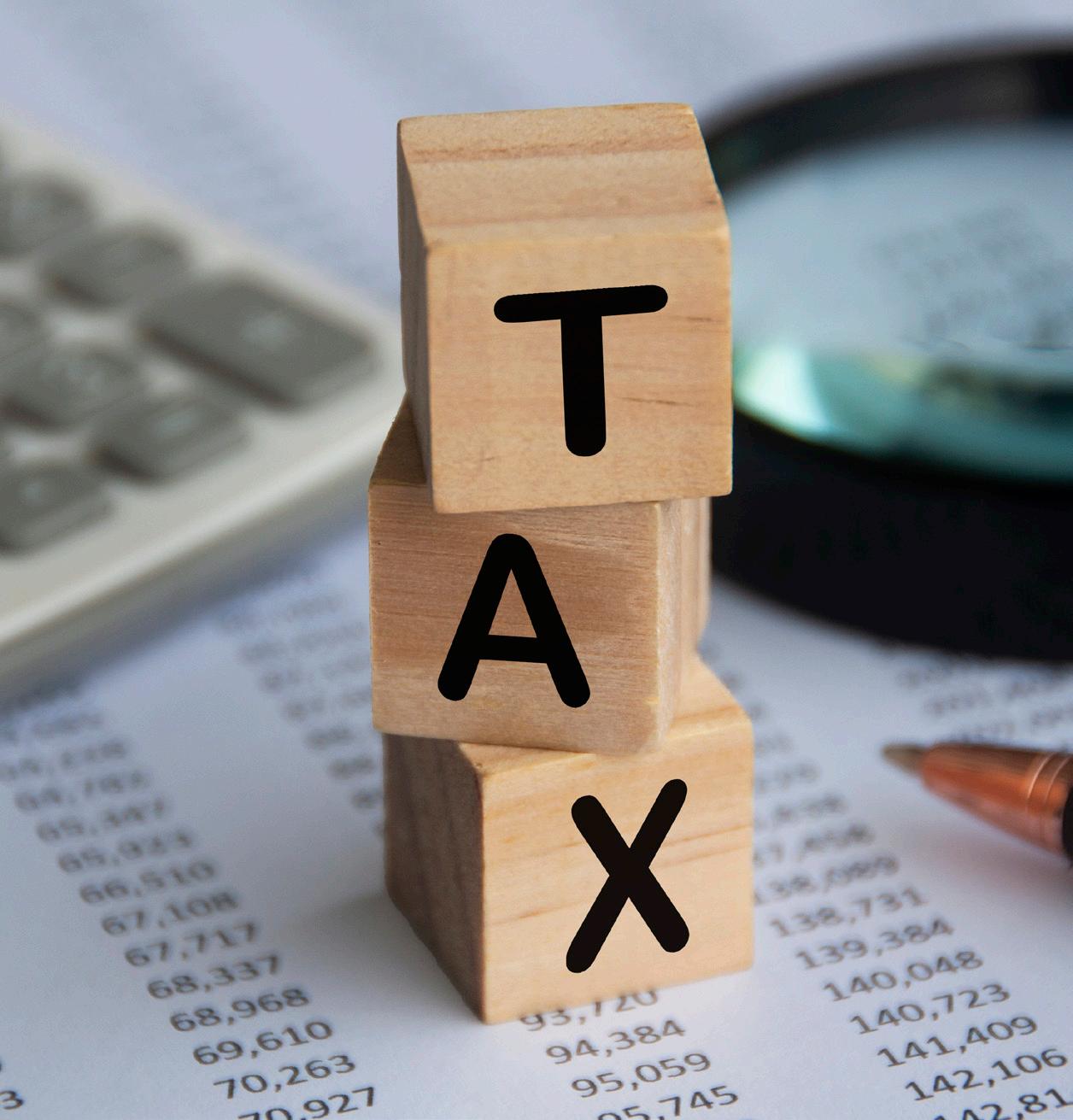

by Joli A. Hohenstein
The future is now—and it’s right here in fields across Illinois and the Midwest. Once the stuff of movies and fan fiction, robots show incredible potential for practical work and impact on Illinois soybean farms. And while sustainability has been intrinsic to every farm, increasing calls and attention for conservation and transparent sustainability are spurring more action and more investment beyond farmers themselves. Fortunately, farmers also stand to reap the benefits.
As with every production decision, adding more sustainable practices on the farm must make fiscal sense. That's top of mind for University of Illinois researchers, who have partnered with EarthSense to explore robotics for cover crops and other applications as part of the iCover Project. “We’re removing the barriers for cover cropping,” says Girish Chowdhary, Ph.D., associate professor, agricultural and biological engineering, computer science, and director of the field robotics engineering and sciences hub. “You can go under the canopy with robots.”
Not only does that allow more flexible timing for cover crop planting, it also means reducing the amount of seed planted. More seed is lost when you seed over canopy, and with robots, you can plant in-season for less hassle and less cost, Chowdhary says.
Clint Brauer shares a similar goal, but his bots are tackling different challenges: weed control and fertilizer. A Kansas farmer, CEO and co-founder of Greenfield Robotics, Brauer has developed bots that ride a half-inch off the ground and physically cut weeds throughout the field.
“Pigweed is a huge problem—people lose control of their fields; I’ve lost control of fields,” he explains. “If you cut them off at the ground, it makes a huge difference.”
It’s a deceptively simple practice that sounds too simple to work. But Brauer and his team have proven it out. Starting with manual testing before moving into the bots, they cut the weeds a half-inch off the ground, typically one to two times a year, sometimes three times in a rainy year. (So far, 80% of their fields have been cut once, and 20% of them twice.)
In addition, Greenfield Robotics has a bot with a shrouded sprayer for nutrient management. “It’s so low to the ground that it limits drifting,” Brauer explains. “Since it’s so low to the ground, you can hit the crop with any foliar feed from around 6 inches up on a 30-inch row crop. You hit only the plant, not what’s between the crop.”
What's more, they’re able to drastically reduce the amount of water used—cutting it by half—because of more precise application and less input use.
These sound like the tales of science fiction. But today they’re reality—and they work.
Brauer will cover 10,000 acres this year, and the iCover Project hopes to reach 200,000 acres by next year.
For the past two years, the iCover Project has used EarthSense robots to plant cover crops at the University of Illinois Farm of the Future and at farms across Illinois and Alabama.
The robots are small and nimble, able to fit between rows and carry 100 lb. of seed. They navigate the rows using proprietary technology and are monitored remotely. (The robots can’t use GPS because moving between the rows creates too much noise, and the robots don’t have a view of the sky from under the canopy.)
So far, the iCover Project team has tested its tech in corn fields. They have plans to expand to soybeans in the future, though Chowdhary says it isn’t much of a leap. They’ve used their robots on a wide variety of cover crops and see the potential for many more.
“We could use them for any cover crops,” says Chowdhary. “Traditional cover crops are used to hold nitrogen and break up compaction: rye, hairy vetch, others, and those used for grazing.”
Greenfield’s first bot was 12 inches wide to fit 15-inch rows. Current models are 15 inches wide to run 30-inch rows. Brauer and his team developed their bots from the ground up—build, install, program, test. They’re running bots in no-till or strip-till soybeans, cotton, sorghum and sunflowers in Kansas and Nebraska.
Starting in 2021, they were able to operate them from anywhere, and from that point on, they’ve been on an upward trajectory. By 2022, they were running on 900 acres; in 2023, 2,500 acres; and this year, they’ll run on 60 fields totaling 10,000 paid acres for 20 farmers.
“Precision ag is easier to deliver at the ground level than from the top down,” Brauer says. “In fact, I believe the equipment is going to go even smaller.”
After spending 13 years in the tech industry before coming back to the family farm, Brauer sees some parallels between it and ag. “Precision ag is similar to other tech adoption,” he says. “Most of our
customers are more adventurous and more early adopters, but that is changing.”
That’s another way robots make it easy. “We start with providing whatever service makes sense for the farmer, and there’s no money down,” Brauer explains. “They sign up for service in advance of the season, and once they see the bots running in the field, we sell out quickly.”
The initial cost for robots is significantly less than other technology such as drones, yet they still deliver fully autonomous capabilities. Chowdhary estimates the cost of using EarthSense robots at $10 to $15 per acre, compared to the $20 per acre farmers are paying for other methods.
The process is simple: Two people can take five robots to cover 80 acres in a day. Put the robots to work in the field, and they visit an automated hopper when they need to refill seed.
“The cost of the robot keeps going down the longer you use it,” he says. “The cost is only the robots and batteries. We feel the potential for the robot
price to go down overall is really significant.”
Additional benefits come from utilizing federal climate-smart practices incentives introduced in recent years. USDA has made more than $3 billion in funding available for agricultural producers and forest landowners nationwide to participate in voluntary conservation programs and adopt climate-smart practices in fiscal year 2024.
U.S. Secretary of Agriculture
Tom Vilsack said, “This funding will be used to meet producer demand for our oversubscribed programs and maximize climate benefits across the country while also providing other important environmental benefits. This includes investing in popular common-sense practices such as cover crops, waste and fertilizer management, and grazing practices, while continuing to work through existing programs to help producers address other natural resource challenges.”
Having this program in place has been key for the iCover
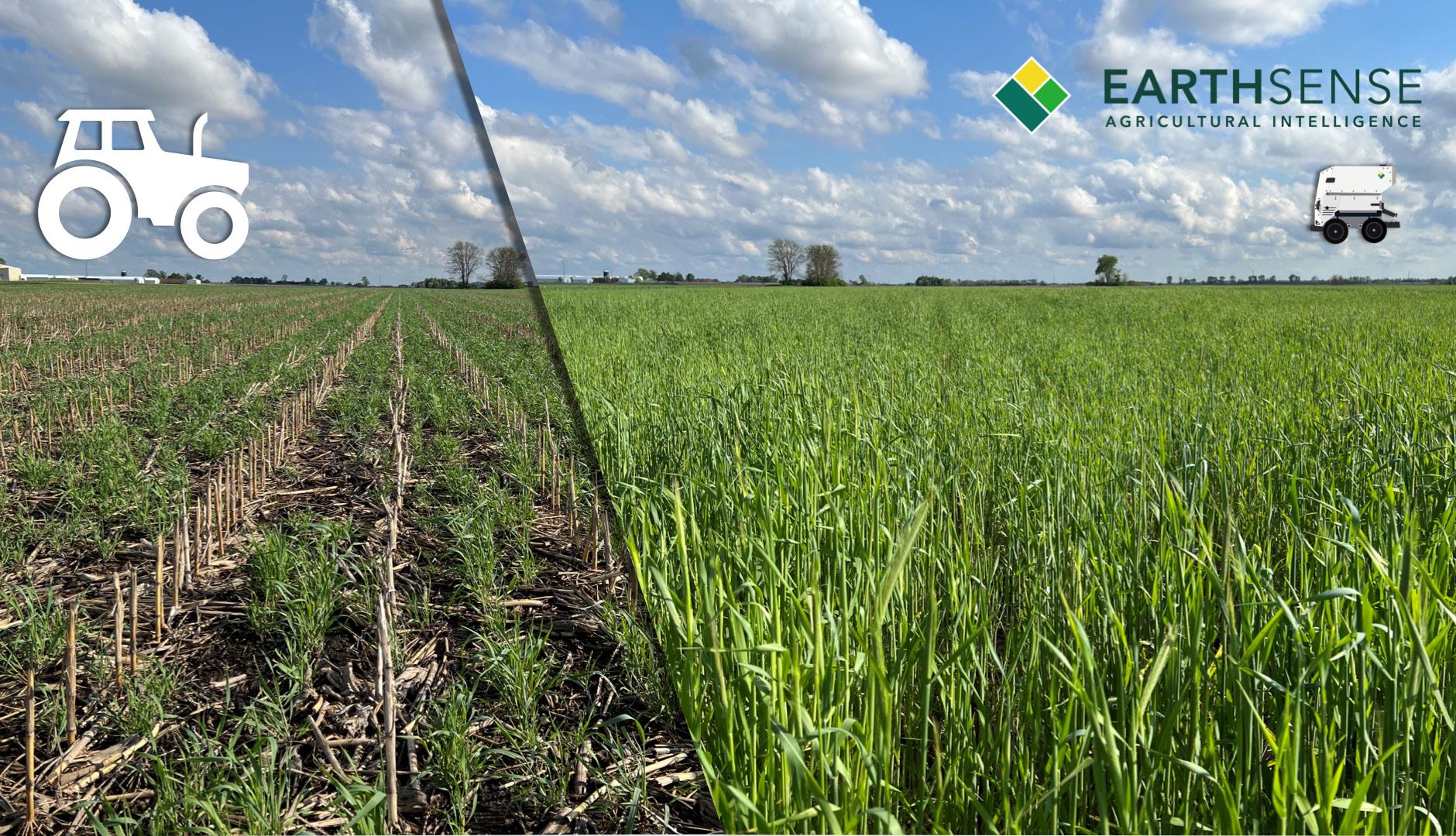
(continued from page 21)
Project, says Chowdhary. “We charge farmers $20, and the climate-smart program takes care of the rest.”
Brauer shares similar sentiments on robots’ low-cost benefits and easy implementation. “It doesn’t take long to make these small machines,” he says. “It’s the training and learning that takes time.”
Greenfield Robotics implements projects by the fleet, so to cover 80 acres, you’d need 10
robots. Their robots can run 2 to 4 mph and make the turn at the end of the row in seconds. They cover a half-acre in an hour with no one at the edge of the field.
“These all run remote,” Brauer says. “We drop them off and go back only to check and change batteries. I could watch them from Illinois or California. They could, in theory, run 24/7, and we’ve run at night a lot.”
Another benefit of robots: they’re easy to scale up or scale down. “All you have to do is put them on a trailer and move them between fields,” he says.
Greenfield charges $25 per acre per task, and additional tasks are discounted. “We’re keeping it simple and static,”
Brauer says. “We have farmers who want to adopt two to five of what we offer.”
Like Chowdhary, he believes the cost of using robots should decrease. “Robots should be like TVs, not automobiles,” he says. “That’s our viewpoint.”
What’s next?
The future holds many options for robotics to help producers level up conservation and make it more profitable.
Brauer has been surprised how quickly farmers’ perspectives have changed in the short time Greenfield Robotics’ bots have been in the field. “A lot of farmers are ready to do something different. That’s been a change,” he says.
“We already have more demand than we can serve.”
Greenfield’s bots are limited only by the attachments they can design. Future bots in the works include versions for planting and eliminating burn down and residual.
An old adage says farmers have 40 chances to grow a crop over a lifetime of production. Brauer doesn’t believe that. “I can grow a cash crop in the summer and a cover crop in between and graze animals,” he says. “I can do multiple crops a year, if I redefine what is a crop. Robots are going to give us more flexibility to do that, and more revenue streams to do it.”



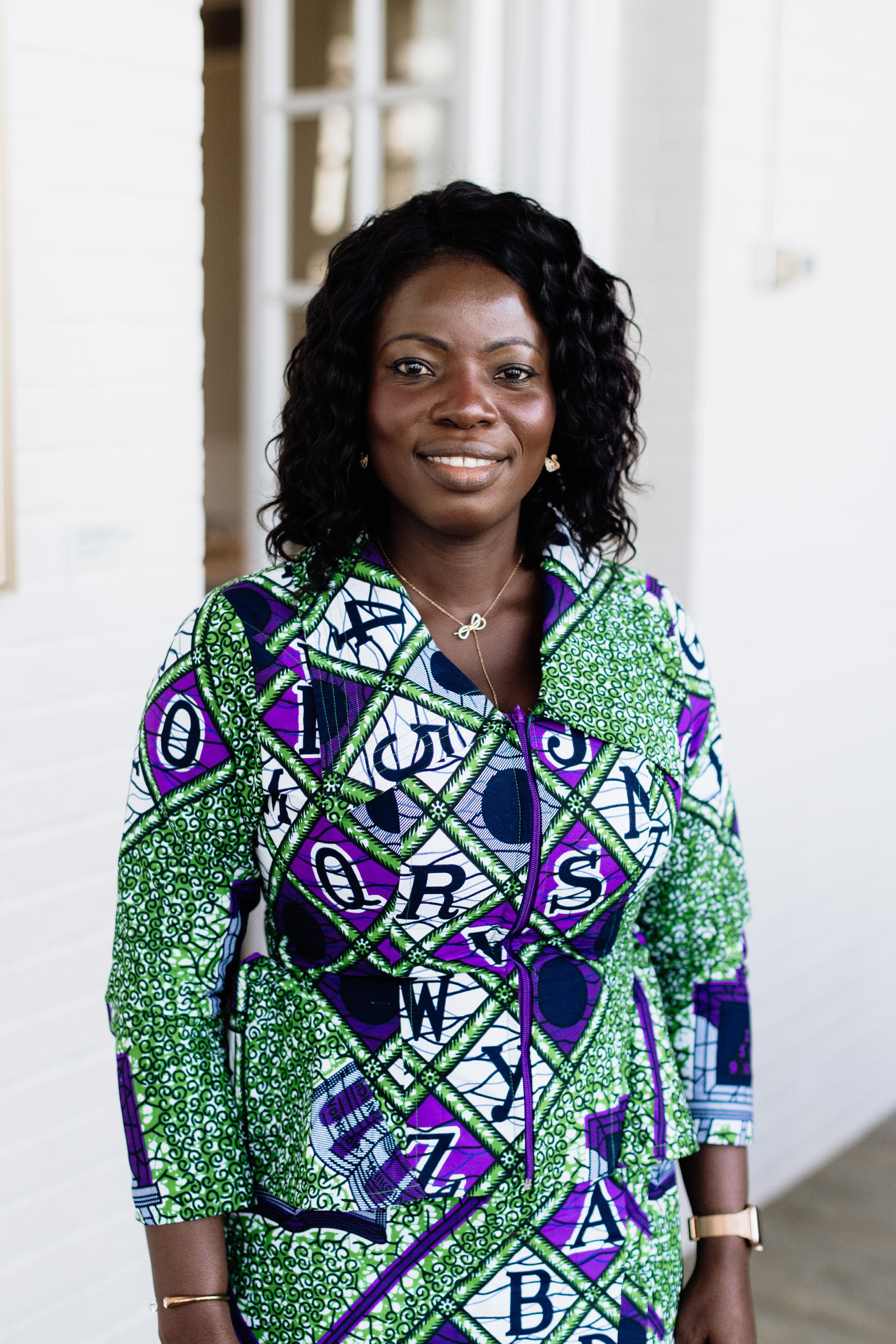
WISHH leverages partnerships for U.S. Soy to help meet the protein needs of 8 billion consumers



By Joli A. Hohenstein
Balancing fall harvest with cover crop planting continues to be a key barrier for many Illinois farmers implementing this beneficial conservation strategy. But new research from University of Illinois Extension aims to help. Scientists are experimenting with different cover crop species along with different planting dates and seeding rates. In the midst of their second year of trials, researchers are gaining a better understanding of ideal planting dates, survivability
across the wide range of weather conditions across the state and the relationship to the spring stand.
The project also aims to improve seeding rate adjustment recommendations based on planting date and region. It will hone target termination timing to help producers achieve optimal cover crop performance.
In the end, researchers say their goal is helping farmers prioritize cover crop planting at the appropriate time to ensure a successful stand as part of a soybean/corn rotation.
At their base, cover crops are planted into crops such as soybeans within or outside of the growing season. Their benefits are many, especially for soil, improving soil quality, organic matter, water-holding capacity and nutrient retention. Added to that, cover crops add nitrogen through fixation. They can control weeds, break disease cycles and reduce erosion. The environment benefits from enhanced biodiversity and increased soil infiltration, which leads to less leaching, flooding and runoff.
Timing is critical for all aspects of cover crops, including:
• Finding the right rotation window
• Identifying the ideal planting date
• Knowing when to terminate
• Planting date is especially critical because it helps farmers in:
• Optimizing successful establishment
• Getting optimal fall growth
• Realizing the desired performance of the cover crop
The University of Illinois study aims to make it easier for Illinois soybean growers to determine a
cover crop strategy and help slip them into an existing rotation.
Research began in 2022 and continued in 2023 at locations across Illinois: Belleville, Ewing, Perry and Monmouth.
Researchers use three planting dates, four seeding rates and two termination timings in cereal rye. They’re trialing multiple cover crops in addition to cereal rye before soybean, including balansa and crimson clover after soybeans at three planting dates.
Preliminary findings support the hypothesis that earlier planting dates yield more spring biomass. In some cases, earlier planting dates with lower seeding rates can provide comparable biomass to the higher seeding rates planted later.
Researchers planted the clovers in three waves. The first planting date was the second
week of October, and the second was the first week of November because of weather conditions that kept them from the field.
“Both species performed really well, with good biomass and growth,” says Nathan Johanning, University of Illinois Extension commercial ag educator.
Balansa clover is a late bloomer. It takes until late April to kick into vegetative growth. “If you want to get in early in that field, it wouldn’t be the choice,” Johanning says. “Even in the first week of May, it took off and took over some winter weeds.”
The final planting date was November 22. Although that cover crop produced less biomass than the two earlier planting dates, Johanning reports it did establish and was performing reasonably well.
“Crimson clover handled mid-October well. That is the happy cutoff for it,” he says. “Balansa
clover clearly has better tolerance of pushing that later planting date.”
Researchers also collected biomass for cereal rye trials, and Johanning says the biggest takeaway was that earlier planting dates proved to have higher biomass.
Researchers also tested different seeding rates: 30, 60, 90 and 120 lbs.
“The difference between the 30 and 120 lbs. rates was noticeable but not significant,” he says. “Most growers wouldn’t plant that high, obviously, but we found that even 30 to 60 lbs. had really good biomass.”
For cereal rye, the first planting date was Sept. 29; the second date was mid-October; the final date was Nov 22.
Johanning says the first two dates look very similar and produced comparable biomass.
“The rye was later to mature at
the later planting dates,” he says. “There is a small influence of planting date on when it matures—maybe a week to 10 days."
The rye also tends to stay shorter, about 4 to 6 inches shorter with the later planting date. That later date doesn’t leave as much time for fall branching and base growth.
Johanning believes the mid- to higher seeding rates of 60 lbs. to 90 lbs. would be beneficial for later planting dates.
“If you plant by mid-November, the middle rate of 60 lbs. provides plenty of biomass,” he says. “If you plant before November, then you definitely can use less than 60 lbs.”
Researchers are finalizing analysis of the 2023 results and in the midst of 2024 trials. Johanning would like to incorporate grasses with the clovers to add diversity to the cover crops after soybeans as another option.

The legislative session in Springfield, which ended in late May, was a whirlwind for many reasons. In previous issues of Illinois Field & Bean, we outlined a few pesticide regulations that were proposed in active legislation this year. We're pleased to report that through diligent and coordinated efforts, agriculture groups were able to stop those bills from gaining any traction this session. All throughout the session, there was buzz that the state would have to prioritize how it planned to get and spend revenue because of projected shortfalls in the budget. In the end, the budget was a contentious item but not the only area that will impact Illinois farmers and landowners.
With around 10 scheduled days left to go in legislative session, our team learned that negotiations and discussions had kicked up once again on legislation to set rules around the process of placing wells and access to land for the purpose of carbon capture and sequestration. These negotiations had been dormant since the previous session concluded in May 2023. Proponents of carbon capture attempted to keep this conversation moving with little success. That is, until Governor Pritzker's office engaged in negotiations in those final 10 days of session. The legislation shifted from focusing only on carbon capture and sequestration wells to including authorizing language and rules around building pipelines, both within Illinois and from adjoining states carrying carbon to well sites.
Our lobbying team had discussions with the Government Relations Board Committee. Their strong feedback? These projects and their use of eminent domain were unacceptable. With this direction, our team engaged vigorously to enter negotiations to protect landowner and farmer rights in this legislation. Unfortunately, there was a strong desire among the proponents to mitigate concerns from the environmental community, while the interests and impact on agriculture were considered but not enacted.
Carbon capture in and of itself is a technology that has potential with new markets for agricultural products such as alcohol-based Sustainable Aviation Fuels (SAF). However, carbon capture legislation, if approved, could have unintended consequences for farmers. For example, it could set markets backward because of a lack of access to Renewable Fuel Standard (RFS) credits for soybean-based biodiesel. One of our main priorities over the summer and leading into next year's legislative session is to continue to understand the impact of this legislation and look for ways to lessen its impact on landowners and farmers.

The other critical piece to watch will be changes to the Pipeline and Hazardous Materials Safety Administration (PHMSA) being developed at the federal level that will apply to all CO2 pipelines in the country. The Illinois legislation does contain a moratorium on the construction of these pipelines until either the PHMSA rules are developed or until two years have elapsed, whichever occurs first.
This issue is one of many our team is advancing on your behalf. We diligently and continually strategize ways to improve the outcomes of proposed legislation on topics such as carbon capture and sequestration. We will hold a series of Illinois Soybean Growers (ISG) membership town halls across the state in August. We hope to see you at one of these events, where we can dive deeper into these issues and continue to gain your feedback to better represent Illinois agriculture in Springfield and Washington, D.C.
Not a current member of Illinois Soybean Growers? Email ashley. barry@ilsoy.org

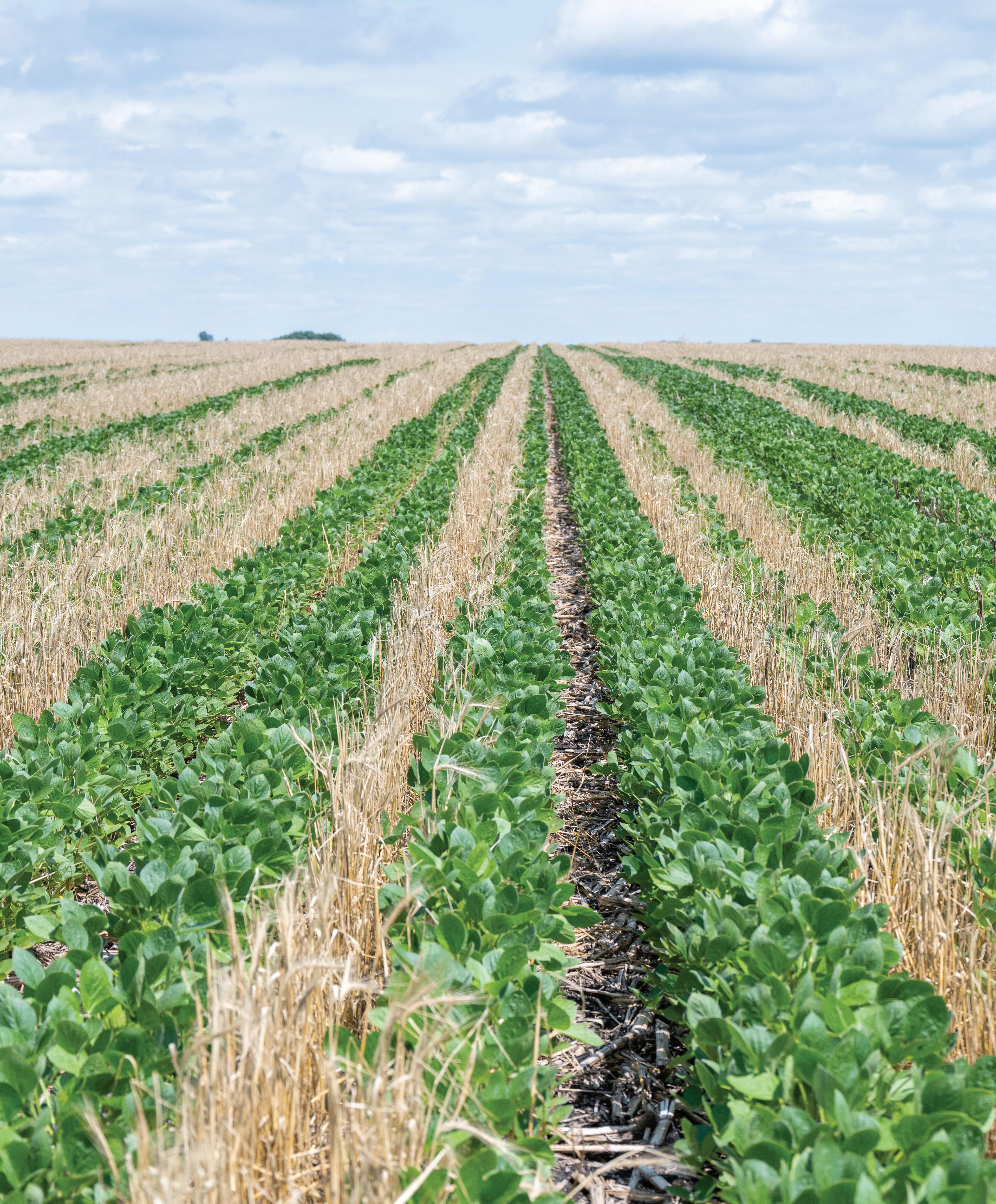
Through the soy checkoff, U.S. soybean farmers are investing in new production practices to continuously improve their sustainability while protecting the air, water and soil for generations to come.
